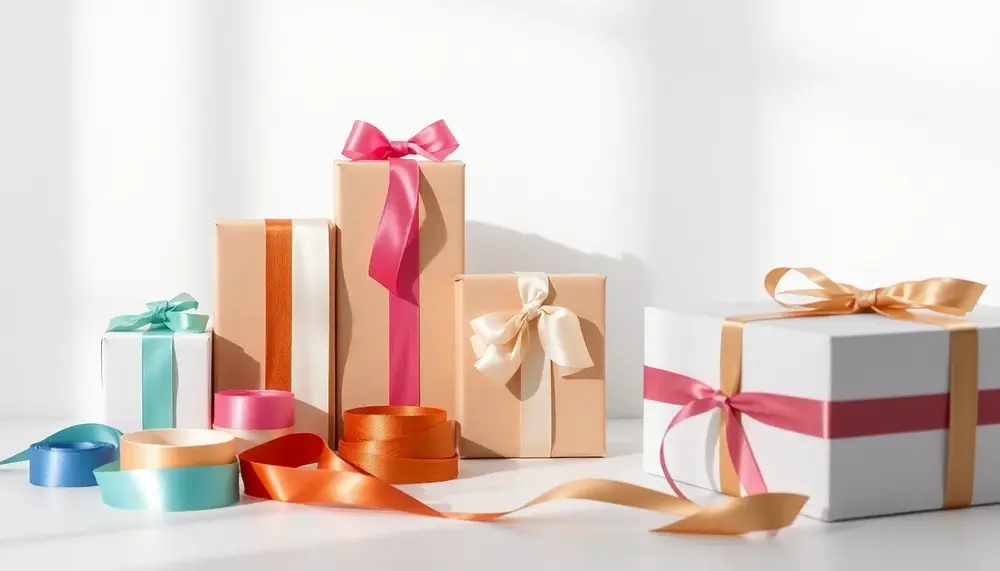Table of Contents:
Understanding Your Product’s Packaging Needs
Before you even glance at a ribbon catalog, pause and take a good, hard look at your product. What story does it tell? Is it delicate, robust, playful, or sophisticated? Packaging ribbons aren’t just an afterthought—they can amplify your product’s personality or, if mismatched, leave customers scratching their heads. Consider these key aspects to zero in on your actual packaging needs:
- Product Dimensions and Weight: Oversized or heavy items need wider, sturdier ribbons to ensure security and visual balance. Tiny or lightweight products? Go for finer, less bulky ribbons that won’t overwhelm.
- Surface and Shape: Odd shapes, textured surfaces, or fragile finishes might call for flexible or non-abrasive ribbon materials. You want a snug fit without risking scratches or slippage.
- Brand Positioning: Is your brand eco-conscious, premium, or fun-loving? The right ribbon can reinforce these messages. For instance, a rustic, handmade soap practically begs for natural raffia or paper twine, while luxury cosmetics might demand lush velvet or double-faced satin.
- Unboxing Experience: Think about how your customer interacts with the package. Should the ribbon be easy to untie for a seamless reveal, or is a more intricate bow part of the excitement?
- Functional Demands: Sometimes, ribbons do more than decorate—they might secure lids, bundle items, or act as a tamper-evident seal. Make sure your choice isn’t just pretty but practical.
Understanding these nuanced needs will save you from costly mistakes and help you select packaging ribbons that don’t just look good, but actually work for your product. In the end, it’s not about the fanciest ribbon—it’s about the right one for your unique offering.
Comparing Packaging Ribbon Materials: Functionality and Aesthetics
Choosing the right ribbon material is a bit like picking the perfect fabric for a custom suit—details matter, and the wrong choice can undermine the whole look. When comparing packaging ribbon materials, it’s not just about color or price; you’re weighing durability, tactile appeal, and the emotional message your packaging sends.
- Satin: Offers a smooth, glossy finish that instantly elevates a package’s perceived value. It drapes beautifully, making it ideal for bows that need to hold their shape. However, satin can show creases and fingerprints, so it’s best for items handled with care.
- Grosgrain: Known for its ribbed texture and matte finish, grosgrain is tough as nails. It resists fraying and holds up well under tension, making it a go-to for heavier boxes or when you want a subtle, tactile contrast.
- Chiffon and Organza: These sheer, airy materials add a whisper of elegance and are perfect for layering or pairing with other ribbons. They’re not as sturdy, but they create a dreamy, soft-focus effect that’s hard to ignore.
- Velvet: The plush, deep texture of velvet ribbons screams luxury. They’re heavier and tend to stay put, but they can be pricey and are best reserved for high-end products or limited editions.
- Raffia and Paper Twine: These natural fibers are a darling of eco-conscious brands. They’re biodegradable, lend a rustic vibe, and can be surprisingly strong. The trade-off? They’re less flexible and can look a bit rough around the edges.
- Metallic and Mesh: If you want to catch the light (and your customer’s eye), metallic or mesh ribbons are the ticket. They’re bold, festive, and durable, but can sometimes feel over-the-top for minimalist brands.
- Acetate: This synthetic option is water-resistant and holds its shape even in humid environments. It’s a workhorse for florists and food packaging, though it lacks the softness of natural fibers.
- Elastic and Stretch Loops: Designed for function, these are perfect for products that need to be opened and closed repeatedly. They’re not the most decorative, but when convenience is king, they deliver.
Every ribbon material has its own quirks—some add polish, others grit. The trick is to balance function and flair, so your packaging feels intentional, not accidental.
Pros and Cons of Different Packaging Ribbon Materials
| Ribbon Material | Pros | Cons |
|---|---|---|
| Satin |
|
|
| Grosgrain |
|
|
| Organza/Chiffon |
|
|
| Velvet |
|
|
| Raffia/Paper Twine |
|
|
| Metallic/Mesh |
|
|
| Acetate |
|
|
| Elastic/Stretch Loops |
|
|
Matching Ribbon Types and Designs to Different Occasions
Pairing the right ribbon type and design with each occasion is where packaging truly comes alive. The wrong choice can feel tone-deaf, while the right one turns a simple box into a memorable experience. It’s not just about colors—texture, width, and even print play a role in how your product is received for birthdays, holidays, or business gifting.
- Weddings & Anniversaries: Go for soft, elegant ribbons like double-faced satin or sheer organza in muted tones—think ivory, blush, or silver. Subtle shimmer or delicate lace patterns add a romantic touch without overwhelming the package.
- Festive Holidays: For Christmas, Hanukkah, or Diwali, metallic ribbons or bold prints with seasonal motifs (stars, holly, snowflakes) instantly set the mood. Layering a metallic mesh over a solid base can create a rich, multi-dimensional effect.
- Birthdays & Celebrations: Curling ribbons or brightly colored grosgrain add energy and fun. Patterns like polka dots, stripes, or even animal prints are great for kids, while sleek, two-tone designs work for adults.
- Corporate Gifting: Choose understated, high-quality ribbons in brand colors. A matte finish or embossed logo can reinforce professionalism. Avoid overly decorative elements—clean lines and subtlety speak volumes here.
- Eco-Friendly & Artisan Events: Natural raffia, recycled paper ribbons, or earthy color palettes highlight sustainability. Hand-tied knots or asymmetrical bows give a handcrafted, authentic feel.
- Limited Editions & Luxury Launches: Velvet or wide satin ribbons in deep jewel tones or black create drama and exclusivity. Pair with gold or silver accents for extra impact.
Matching ribbon types and designs to the occasion isn’t just a detail—it’s a strategic move that amplifies your product’s message and creates an emotional connection with the recipient.
Key Criteria for Selecting the Best Packaging Ribbons
Zeroing in on the best packaging ribbon for your product means thinking beyond the obvious. The devil’s in the details, and those details can make or break your customer’s first impression. Here’s what savvy brands actually consider—often behind the scenes—when making their ribbon choices:
- Consistency Across Batches: Will the ribbon look the same from one order to the next? Color variations or texture shifts can undermine your brand’s reliability, especially if you’re packaging at scale.
- Colorfastness and Fade Resistance: If your products might sit in sunlight or under store lights, check that the ribbon won’t bleed or fade. A faded bow can make even the best product look tired and old-stock.
- Print Compatibility: Planning to print your logo or a custom message? Not all ribbons take ink or foil equally well. Test samples to avoid smudging, peeling, or uneven finishes.
- Allergen and Safety Concerns: For food, baby, or cosmetic packaging, ensure ribbons are free from harmful chemicals, strong odors, or allergens. Certifications or lab test results can be a real plus here.
- Ease of Automation: If you use machines for tying or decorating, the ribbon’s flexibility and surface finish matter. Some materials snag or jam more easily, which can slow down production and hike up costs.
- Storage and Shelf Life: Some ribbons attract dust, absorb moisture, or become brittle over time. Opt for materials that hold up well in your specific storage conditions—especially if you buy in bulk.
- Minimum Order Quantities (MOQs): Don’t get caught off guard by supplier requirements. MOQs can affect your cash flow and inventory space, so align your ribbon choice with your actual packaging volume.
- Disposal and End-of-Life: Consider how your customer will dispose of the ribbon. Is it recyclable, compostable, or reusable? This small detail can boost your sustainability story and brand reputation.
These criteria help you avoid costly surprises and ensure your packaging ribbon not only looks good but works for your business—now and in the long run.
Examples: Practical Ribbon Choices for Real-World Products
Let’s get straight to the point—choosing the right ribbon isn’t just theory. Here are concrete, real-world product scenarios and the ribbon choices that actually deliver, based on what works in practice (and sometimes, what doesn’t):
- Handmade Soap Bars: A narrow, natural paper ribbon with a printed kraft tag. This combo stays put on slightly textured paper wraps, doesn’t get soggy in humid shop environments, and reinforces the artisan vibe.
- Luxury Chocolate Boxes: Wide, double-faced satin in deep burgundy or navy, finished with a subtle gold foil logo. The ribbon is thick enough to keep its bow shape, and the smooth surface makes the unboxing feel indulgent.
- Subscription Gift Boxes: Grosgrain ribbon in brand colors, pre-tied into stretch loops. This speeds up packing, holds boxes securely closed, and stands up to shipping jostles—plus, customers can reuse the ribbon.
- Florist Bouquets: Water-resistant acetate ribbon in bright spring colors. It’s easy to tie around stems, won’t wilt or bleed if sprayed, and can be curled for extra flair.
- Children’s Birthday Party Favors: Curling ribbon in rainbow shades. It’s inexpensive, quick to use, and adds a festive pop—kids love pulling the curls, and it holds up even if handled roughly.
- Eco-Friendly Candle Packaging: Raffia ribbon in earthy tones, paired with a recycled-paper tag. The ribbon is compostable, and the rough texture complements natural wax finishes.
- Corporate Holiday Gifts: Matte-finish, custom-printed grosgrain in subtle metallics. It matches the company’s branding, resists fraying, and looks sharp in group photos for social media posts.
These choices aren’t random—they’re based on what actually works for specific products, packaging workflows, and customer expectations. If you want your packaging to hit the mark, use real-world needs as your north star, not just trends or guesswork.
Embracing Sustainability in Packaging Ribbon Selection
Embracing sustainability in your packaging ribbon selection isn’t just a nod to eco-trends—it’s a tangible way to align your brand with evolving consumer values and regulatory expectations. Customers are scrutinizing not only what’s inside the box, but every element of the presentation, ribbons included. Here’s how to make your ribbon choices genuinely sustainable and credible:
- Certified Eco-Materials: Seek out ribbons made from FSC-certified paper, organic cotton, or recycled polyester. Certifications like OEKO-TEX STANDARD 100 or Global Recycled Standard (GRS) add transparency and trust.
- Minimalist and Multi-Use Designs: Opt for simple, uncoated ribbons that can be reused, repurposed, or composted. Avoid excessive printing, glitter, or coatings that hinder recyclability.
- Local Sourcing and Short Supply Chains: Choosing ribbons produced closer to your packing facility reduces transportation emissions and supports local economies. Ask suppliers about their sourcing and production footprint.
- Supplier Accountability: Work with vendors who publish clear environmental policies and can provide lifecycle data for their products. A transparent supply chain is a powerful differentiator.
- Consumer Communication: Clearly label your packaging to inform customers about the ribbon’s sustainable attributes and disposal options. A small note can encourage recycling or composting, extending your impact beyond the sale.
Incorporating these strategies not only reduces your environmental footprint but also strengthens your brand’s credibility in a marketplace where greenwashing is increasingly called out. Authentic, well-documented sustainability in ribbon selection can set your packaging—and your business—apart.
Pricing and Sourcing: Maximizing Value for Your Business
Getting the most out of your packaging ribbon budget is less about penny-pinching and more about making smart, strategic decisions. The real value lies in balancing quality, brand fit, and supply reliability—without letting hidden costs eat into your margins. Here’s what separates savvy buyers from the rest:
- Volume Discounts and Tiered Pricing: Suppliers often offer significant price breaks at higher order quantities. Calculate your annual or seasonal needs in advance and negotiate for tiered pricing, rather than buying piecemeal.
- Direct-from-Manufacturer Sourcing: Skip the middlemen when possible. Going straight to manufacturers can unlock better rates, more customization options, and direct access to production timelines.
- Private Label and Customization: If you need branded ribbons, ask about private label programs. Some suppliers offer custom printing or color-matching at surprisingly low minimums, which can elevate your packaging without breaking the bank.
- Sample Orders and Quality Assurance: Always request samples before committing to a large order. This minimizes the risk of costly mismatches or defects, especially if you’re testing a new supplier or material.
- Shipping, Duties, and Lead Times: Factor in the full landed cost, not just the ribbon’s sticker price. International sourcing may seem cheaper, but shipping fees, import duties, and longer lead times can quickly erode savings.
- Supplier Reliability and Support: Choose partners with a track record of on-time delivery and responsive customer service. Delays or communication breakdowns can disrupt your packaging schedule and cost far more than a few cents saved per yard.
- Market Trends and Material Availability: Stay informed about shifts in raw material costs or supply chain disruptions. Locking in prices with longer-term contracts or exploring alternative materials can shield your business from sudden price spikes.
By focusing on these practical sourcing strategies, you’ll not only control costs but also build a more resilient, value-driven packaging operation—one that can flex with market changes and keep your brand looking sharp.
Ordering, Delivery, and Support: What to Expect
Ordering packaging ribbons for your business should be a smooth, transparent process—if you know what to expect and what to ask for. Here’s how the best suppliers stand out and what you should look for to avoid headaches down the line:
- Clear Quoting and Order Confirmation: Expect a detailed quote outlining product specs, quantities, pricing, and any setup or customization fees. A professional supplier will confirm your order in writing, including estimated production and delivery timelines.
- Production Updates: Reliable partners provide proactive updates if your order is delayed or if there are material shortages. Some even offer tracking portals so you can monitor progress in real time.
- Flexible Delivery Options: Look for suppliers offering express, standard, and bulk freight shipping. The ability to split shipments or schedule deliveries can be a game-changer for businesses with fluctuating demand.
- Accurate Tracking and Documentation: You should receive tracking numbers and clear documentation for each shipment, including packing lists and, if needed, certificates of origin or compliance for customs clearance.
- Responsive Customer Support: Top suppliers provide dedicated account managers or support teams who respond quickly to queries—by phone, email, or chat. They’ll help resolve issues like order discrepancies, returns, or urgent reorders without hassle.
- After-Sales Service: Expect a follow-up to ensure your order meets expectations. Some suppliers offer reorder reminders, feedback surveys, or even stock management services for regular clients.
By choosing partners who deliver on these points, you set your business up for fewer surprises and a packaging process that runs like clockwork—even when demand spikes or last-minute changes crop up.
Expert Tips for Tailoring Packaging Ribbons to Your Brand
Customizing packaging ribbons isn’t just about picking a color that matches your logo. To truly tailor ribbons to your brand, consider these advanced strategies that top packaging designers and brand managers swear by:
- Layering and Texture Mixing: Combine different ribbon types—like a matte grosgrain base with a narrow satin overlay—to create a tactile, multi-dimensional look that stands out on shelves and in photos.
- Signature Ribbon Techniques: Develop a unique tying style or bow shape exclusive to your brand. This small detail can become a recognizable part of your unboxing experience and boost brand recall.
- Seasonal and Limited-Edition Variations: Introduce subtle changes for holidays or product launches, such as a metallic thread or a custom-printed motif. This keeps your packaging fresh and gives customers a reason to look forward to each release.
- Color Psychology Alignment: Choose ribbon shades that evoke the emotions you want associated with your brand—calming blues for wellness, energetic reds for excitement, or earthy greens for sustainability.
- Personalization at Scale: Use variable data printing to add customer names, event dates, or special messages directly onto ribbons for VIP orders or corporate gifting, creating a one-of-a-kind experience without manual labor.
- Storytelling Through Details: Incorporate subtle design elements—like a hidden icon, slogan, or brand story snippet—into the ribbon’s print or weave, offering a small discovery moment for attentive customers.
These expert tactics go beyond the basics, helping your packaging ribbons become a true extension of your brand identity—memorable, shareable, and unmistakably yours.
FAQ: Selecting the Ideal Packaging Ribbon for Your Brand
What ribbon material is best for gift packaging?
The best material depends on your product and brand. Satin offers a luxurious glossy finish, grosgrain is robust for heavier parcels, and eco-conscious options include raffia or paper ribbon. Consider both appearance and practicality when choosing.
How do I choose the right ribbon width for my packaging?
Select ribbon width based on the size and weight of your package. Wider ribbons suit large or heavy boxes, while narrow ribbons are best for small or delicate items to avoid overwhelming the product.
Which ribbon types are most sustainable?
Sustainable ribbon choices include those made from recycled materials, organic cotton, paper, raffia, or those carrying certifications such as OEKO-TEX STANDARD 100 or FSC. These options support eco-friendly initiatives and responsible sourcing.
What factors should I consider when selecting ribbon designs for special occasions?
Match ribbon colors, patterns, and textures to the occasion and your brand identity. Weddings favor subtle satins and organza; holidays work well with metallic or printed ribbons; corporate gifts benefit from refined, branded grosgrain or satin ribbons.
How can I maximize value when sourcing packaging ribbons for my business?
Take advantage of volume discounts, request samples before purchasing in bulk, and work directly with manufacturers when possible. Also, factor in customization options, delivery costs, and supplier reliability to ensure the best overall value.






